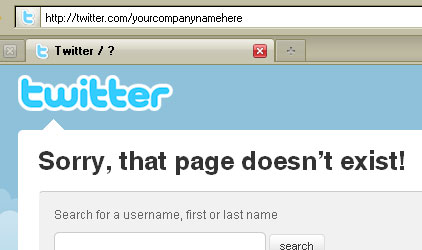Next likemind Chicago on Friday December 4
 The next likemind will be Friday, December 4, 2009 in dozens of cities around the world.
The next likemind will be Friday, December 4, 2009 in dozens of cities around the world.
In Chicago, it will be at Argo Tea, 140 S Dearborn St. at the corner of Adams and Dearborn Streets in the Loop from 8:00 am to 10:00 am.
For November and December, likeminds are combined into one with the global holiday schedule.
I call likemind a gathering of creative-minded people, from various disciplines including Internet, advertising, art, social media, et. al. For more information on likemind, you can read this great article on likemind from the New York Times.
No RSVP is required. You are also welcome to join the likemind Chicago Facebook group.
Did you enjoy reading this? You are welcome to subscribe to The Hot Iron by RSS feed or by email.
Get Your Name On Twitter
Whether or not you plan on using Twitter any time soon, get your name on it now. Register for the microblogging service and create a basic profile with a URL link to your Web site.
Why? The main reason is more and more people are using Twitter and these people have a great expectation for other people and companies to be there as well. People will try looking up a person or entity by simply trying their name after twitter.com, as shown below.

If they can’t find you, they will try to search for you. If they still can’t find you, they will probably post a tweet stating they couldn’t find you.
Another reason to at least set up the account is someone else may do it before you. Squatting on personal, company and brand names is becoming common it Twitter, just as it is still common with domain names. The simple, inexpensive way is to get the name now and avoid the hassle later if someone else gets it before you do, just as it is with domain names.
Once you have your Twitter account, make a plan to start using it. Spend some time exploring Twitter, read any number of blogs and articles on it, and see who else is using it, especially in your market and industry. Look for more on Twitter and social media from Dunkirk in the future.
Consider Twitter as you would any other tool for your business, as others will have that expectation of you. And when you do start using it, follow me.
Did you enjoy reading this? You are welcome to subscribe to The Hot Iron by RSS feed or by email.
Analogy Of Buying A Car And Web Site Scope
 When it comes to explaining the process and elements of Web design and development, I find myself using analogies to the real world. Though they sometimes feel cliché to me, they do help many clients and prospects to understand what they are about to get into.
When it comes to explaining the process and elements of Web design and development, I find myself using analogies to the real world. Though they sometimes feel cliché to me, they do help many clients and prospects to understand what they are about to get into.
One common one is comparing the scope of a Web site project with buying a car. Imagine going into an auto superstore or an extensive used car store and a salesperson asks, “can I help you?” This scenario is similar to when someone comes to me and states, “I want a Web site but I don’t know where to start.”
Many of the same considerations come into play, and here’s a few of them matched up.
Car – How many people do you need to transport?
Web – How large is your firm/organization?
Car – What accessories do you want?
Web – What features do you want for the Web site, such as eCommerce, blog, etc.?
Car – Are you the only driver or are there others?
Web – Will others be maintaining the information on the Web site?
Car – Do you have a trade-in?
Web – Do you currently have a Web site?
Car – What is your budget?
Web – What is your budget?
There are many others I have used, but these examples help both the Web site owner and the consultant to determine the scope of the Web site, including features, functionality and content. I also have other analogy categories I will share another time.
Do you find analogies of this sort helpful?
Did you enjoy reading this? You are welcome to subscribe to The Hot Iron by RSS feed or by email.
Anybody Can See A Public Web Site Or Blog
Though it may be obvious to most everybody, I must reiterate that it is all possible that anybody can see any public Web site or blog. When I say public, I am speaking of any Web page which is not password-protected or is in a “walled garden” like a company Intranet or Facebook. In other words, if it’s out there, it’s out there.
In the early days of the Web, most everybody who was putting information on the Web was putting too much information out there. Present company included! We all got wise as to how to structure and craft content to meet the needs of the Web visitor as well as ourselves and became more strategic about what was put out there for all to see. But with the proliferation of Web platforms where anyone could publish content, you would start to see more and more go out there than was required or necessary. It started with sites like Geocities and has continued to blogging platforms like WordPress, where anyone can publish a blog for free.
Believe it or not, much thought goes into what I write, namely as I write it in Word before I post it. But I continue to read people’s blogs and Web sites where they put too much information out there. What do I mean? Everything from family photos to vacation schedules to start qualify as too much information. I have talked to some people about this and they tell me nobody but close friends know the link to the blog or Web site. Where that may be the case, it is still a public link, and anybody has the potential to see it, and use it to your disadvantage.
Think strategically when you put information on the Web. If it is information for everybody to see, craft the message and create a Web design to make it easy to do so. But if it is private information, consider password-protection on the Web page, or just don’t post it at all. For if it is out there, it’s out there.
Did you enjoy reading this? You are welcome to subscribe to The Hot Iron by RSS feed or by email.
Meetings And Events Need Greeters
Have you ever been alone in a crowded room? It can easily happen, when you first enter a room or area where a meeting or event is going on. It can be crowded or even spread out with a few people. You don’t know anyone and nobody knows you. If you read any number of networking resources, there are all kinds of advice and tips to tackle this situation and make it work for you.
But what if it doesn’t work? What if you just can’t crack into the audience? Is it solely your fault? Of course not! Somebody or some organization spent time and money to put on this event, extended an invitation to you and others, and then they leave it to others to ensure its event? This failure in logic is the direct result of not having facilitators or greeters in order to prevent situations like this.
Proven In Action
When I was involved in the Boston Jaycees and eventually became its president, I learned first-hand how having greeters made our meetings more successful. We held monthly membership meetings, and the second someone entered the room they needed to check-in. Everybody wore nametags – members would have one color border on their tag and guests another. This way, any member of the board of the Jaycees, as well as general members, would be able to know who was new and reach out to them. We held an orientation a few minutes before the meeting started for guests to welcome them and give them an overview of the organization and the meeting itself, so when it commenced they would be in the know as to what was transpiring.
As a result, new guests felt welcomed and it helped break the ice for them in a room where most people knew each other. For the Jaycees, as we were a membership organization looking to grow, we were easily able to identify people and connect with them. Where we had specific membership people who would seek out people, as a result of the color-coded nametags, all members automatically became greeters, namely because many of them had a similar, engaging experience when they first came to a meeting.
The Opposite Proven In Action As Well
A few years back my wife and I went to a local networking event for a business organization in Chicago whose name is purposely being withheld. I was on their mailing list, but had no other connection to them or knew anyone involved. As we entered the meeting area, there was a check-in table, but after that we were purely on our own. The attendees appeared to know each other from our observation. Many people had nametags indicating they were officers of the organization. But as we moved through the room, we found people did not want to engage with us, despite our efforts to reach out to many people. We got frustrated, namely as this was billed as a networking event and welcomed non-members. My wife made a last-ditch effort by boldly going up to several individuals, including those with nametags, but nobody had any interest in talking with us! Needless to say we left, and that’s all we talked about the remainder of the night.
It Doesn’t Take Much
A couple of packs of nametags was the way we at the Jaycees were able to identify new people, not to mention a culture of welcoming. If you are going through the cost and effort to hold an event or meeting, why not ensure people get as great of a return on the event as you do? Or put it like this – could your event or meeting be less successful because you do not do this? I could have easily mentioned the name of the organization I slammed above, and someone else may not be as kind.
Did you enjoy reading this? You are welcome to subscribe to The Hot Iron by RSS feed or by email.

